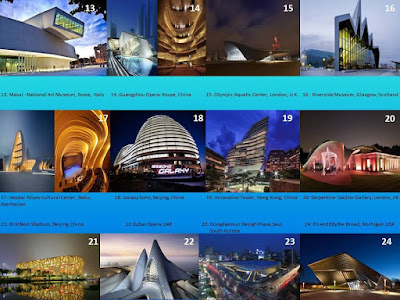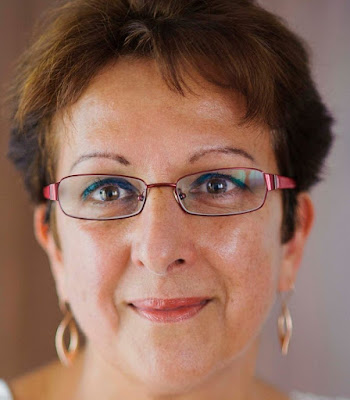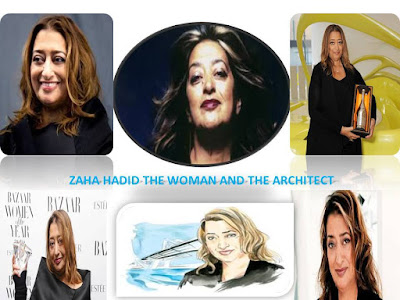Zaha Hadid - the woman and the architect
Zaha Hadid, arhitecta britanica de origine irakiana, prima femeie laureata a premiului Pritzker - considerat drept Nobelul pentru arhitectura, a murit in martie 2016.
A plecat pe drumul pe care pleaca toate mintile si sufletele indraznete si geniale, asa cum a venit, "cu mainile goale", dar lasand in urma ei marca unei personalitati unice.
Nascuta la Bagdad in 1950, intr-un Irak deschis, mult mai pasnic si foarte diferit de cel cunoscut in zilele noastre, ea a fost incurajata de parinti spre scoala si cariera. Astfel, Zaha Hadid a studiat matematica la Universitatea Americana din Beirut, formandu-se apoi la Architectural Association School of Architecture din Londra, unde a devenit ulterior profesoara. Dupa absolvire, a avut sansa, gratie talentului ei deosebit, sa lucreze cu Rem Koolhaas si Elia Zenghelis, la Office for Metropolitan Architecture, unde a devenit partener in 1977.
In alegerile de viata si in construirea unei cariere, a fost permanent incurajata de parintii sai, intelectuali, implicati puternic in viata economica si sociala a tarii si dornici sa o vada pe tanara Zaha atingandu-si potentialul si visurile. Iar visurile acestei femei cutezatoare si vizionare au devenit realitate. Incepand cu 1979, a conceput peste 950 de proiecte, multe dintre acestea realizate in 44 de tari. Puterea ei extraordinara de munca si darzenia, dar si dorinta de a crea ceva nou, ceva ce parea dificil sau chiar imposibil de construit, au condus-o pe culmile glorie. Plina de avant si stiind ca are ceva de demonstrat, in 1980 isi deschide propria afacere la Londra, afacere care s-a dezvoltat, fiind prospera si in prezent, consolidandu-si in timp statutul de referinta in arhitectura contemporana si de perspectiva.
Zaha Hadid nu a fost casatorita niciodata si nu a avut copii. A fost considerata o fire dificila, dar cei care au iubit-o si au admirat-o, au vazut dincolo de orice aparenta, persoana extraordinara care era ea! Imbracata preponderent in negru, purtand ruj rosu, parca pentru a-i accentua si mai mult ochii imensi, admirata pentru stilul vestimentar elegant si stilat, considerata o diva (ceea ce nu-i placea deloc - “Will they call me diva if I was a man?”), Zaha Hadid impresiona si ca persoana, si ca arhitecta.
Fiind supranumita si "star-hitecta", ea a fost, de-a lungul vietii, arhitecta profesionista de talie internationala si deschizatoare de drumuri, femeie de afaceri, profesoara la universitati de prestigiu din intreaga lume, trendsetter in viata si in arhitectura. A fost cea care a revolutionat un domeniu, chiar daca unele dintre creatiile ei nu au fost construite, fiind considerate prea costisitoare sau prea vizionare: Peak Club din Hong Kong (1983) si Cardiff Bay Opera House din Wales (1994). A primit numeroase premii si distinctii (unele dintre acestea fiind oferite in premiera unei femei), a fost membra in consiliul editorial al Encyclopaedia Britannica si a fost inclusa de catre Forbes, in 2008, pe lista celor mai puternice 100 de femei din lume. In 2010, a fost nominalizata de catre publicatia Time ca "influential thinker", iar in 2014, Heydar Aliyev Cultural Centre, proiectat de ea, a castigat premiul oferit de Design Museum - Design of the Year Award, Zaha Hadid devenind astfel prima femeie care a castigat vreo data aceasta distinctie.
Datorita luptei permanente pe care a purtat-o pentru a-si impune viziunea arhitecturala specifica mai degraba oraselor viitorului, ea a avut parte de recunoastere si apreciere la nivel international. Dar si-a dedicat viata exclusiv acestei lupte si acestei afirmari. A fost o femeie care, poate, nascuta in alta familie, in Irakul de azi, s-ar fi pierdut undeva, intr-un colt de lume. Sau poate nici nu s-ar fi nascut. Sau poate nu ar fi avut sansa de a supravietui razboiului, pentru a creste si pentru a deveni reper in istoria arhitecturii. Si da, nu pot sa nu ma intreb: cate Zaha Hadid pierdute, uitate si nestiute nu exista in lume? Da, ea s-a nascut in cel mai favorabil context posibil si a avut sansa, pe langa talentul zdrobitor, sa aiba si un caracter pe masura! Oricum, reusita ei intr-un domeniu preponderent masculin a clatinat metalitati si a schimbat tipare. Din ce in ce mai multe femei abordeaza cu succes si se fac cunoscute in acest domeniu redutabil: Suman Sorg, Anne Fougeron, Katherine McGraw Berry sunt nume importante in ceea ce inseamna arhitectura ridicata la rang de arta.
In 2004, la primirea premiului Pritzker, Zaha Hadid spunea: “I think that it seems you can really break the glass roof!” ("Se pare ca tavanul de sticla chiar poate fi spart!"). Iar in ceea ce priveste numeroasele obstacole pe care le-a avut de infruntat pentru a-si impune viziunea si creatiile, ea afirma ca:“I don’t know if people behave to me in that way because I am eccentric, stranger, funny or because I am a woman…” ("Nu stiu daca oamenii se poarta astfel cu mine pentru ca sunt excentrica, ciudata, amuzanta sau pentru ca sunt femeie.")
Si aceste vorbe, venind din partea unei profesioniste aparent rasfatate de soarta ne cam pun pe ganduri...
Acum, am placerea sa va las in continuare sa va bucurati ochii si sufletul admirand cele mai frumoase dintre creatiile Zaha Hadid. Cu o rugaminte: de a nu uita ca, daca ne bucuram acum de facilitatile oferite de calculatoare ultraperformante, acest lucru se datoreaza (si) unei femei, considerata a fi cea care a scris primul program de calculator din lume: Ada Lovelace.
Enjoy!
- ENGLISH VERSION -
Zaha Hadid, the British architect of Iraqi origin, the
first woman ever laureate of the Pritzker prize - considered the Nobel
for architecture, died in March 2016.
She left on the road that goes all bold and brilliant minds and souls as she came, "empty-handed", but leaving behind the marks of an unique personality.
Born in Baghdad in 1950, in an open Iraq, much more peaceful and very different from the one known today, she was encouraged by parents for school and career.
Thus, Zaha Hadid studied first mathematics at the American University of Beirut, and later on, the architecture at the Architectural Association School of Architecture in London, where she became a teacher.
After graduating she worked with Rem Koolhaas and Elia Zenghelis at the Office for Metropolitan Architecture, becoming a partner in 1977.
In life choices and building a career, she has been always encouraged by his parents, intellectuals, strongly involved in the social life of the country and eager to see young Zaha reaching its potential and dreams. And the dreams of this woman audacious and visionary have become reality. Since 1979, she has designed more than 950 projects, many of them carried out in 44 countries. Her tremendous work capacity and her resolution, but also the desire to create something new, something that seemed difficult or impossible to be built, soar her to the heights of fame in the architecture.Full of impetuosity and knowing that she has something to prove, in 1980 she opened her own business in London, business that has developed, and currently being prosperous, while reinforcing its status of reference in the contemporary and perspective architecture.
Zaha Hadid was not never married and had no children. She was considered a difficult character, but those who loved and admired her, have seen beyond those appearances, the extraordinary person that she was! Dressed mostly in black, wearing red lipstick as to emphasize even more her huge eyes, she was admired for hers elegant and stylish fashion style, considered a diva (which she did not like at all - “Will they call me diva if I was a man?”), Zaha Hadid was impressive both as a person and as an architect. Being known as the "star-architect," she was throughout her life, a professional, a world-class architect and a pioneer, a businesswoman, a teacher at prestigious universities worldwide, and a trendsetter in life and architecture. She was the one who revolutionized a domain, even if some of her designs were not built, being considered too costly or too visionary: The Peak Club in Hong Kong (1983) and the Cardiff Bay Opera House in Wales (1994). She received numerous prized and awards in architecture (some of those never offered to a woman before), she was also on the editorial board of the Encyclopaedia Britannica, in 2008, she ranked 69th on the Forbes list of "The World's 100 Most Powerful Women". In 2010, she was named by Time as an influential thinker in the 2010 TIME 100 issue, and in 2014, the Heydar Aliyev Cultural Centre, designed by her, won the Design Museum Design of the Year Award, making her the first woman to win the top prize in that competition.
Because this permanent struggle that she has taken to impose her architectural vision, rather specific to future cities, she won the international recognition and appreciation. But she has dedicated her life exclusively to this fight and this statement. She was a woman who maybe born in another family, in the contemporary Iraq, would be lost somewhere in the world. Or maybe she would never been born. Or maybe she would never had the chance to survive the war, to grow and to become a benchmark in the history of architecture. And yes, I can not help but wonder: how many Zaha Hadid are lost, forgotten and unknown somewhere in the world? Yes, she was born in the most favorable context possible and she had the chance, besides a smashing talent, to have a powerful character! However, her success in a predominantly male domain shook mentalities and changed patterns. Increasingly more women successfully address and become known in this redoubtable domain: Suman Sorg, Anne Fougeron, Katherine McGraw Berry are important names in what means architecture elevated to the art.
In 2004, when receivingmPritzker Architecture Prize, Zaha Hadid e stated that: “I think that it seems you can really break the glass roof!” And regarding the many obstacles that she had to face in order to impose her vision and creations, she stated that:“I don’t know if people behave to me in that way because I am eccentric, stranger, funny or because I am a woman…”
And those words, coming from a apparently spoiled professional, make all of us to think again...

Now, I am pleased to let you enjoy your eyes and soul admiring the most beautiful creations of Zaha Hadid. But I kindly ask you that: do not forget that if we now enjoy the facilities offered by high performance computers, this is due (also) to a woman, regarded as being the one who wrote the first computer program in the world: Ada Lovelace.
Enjoy!









































